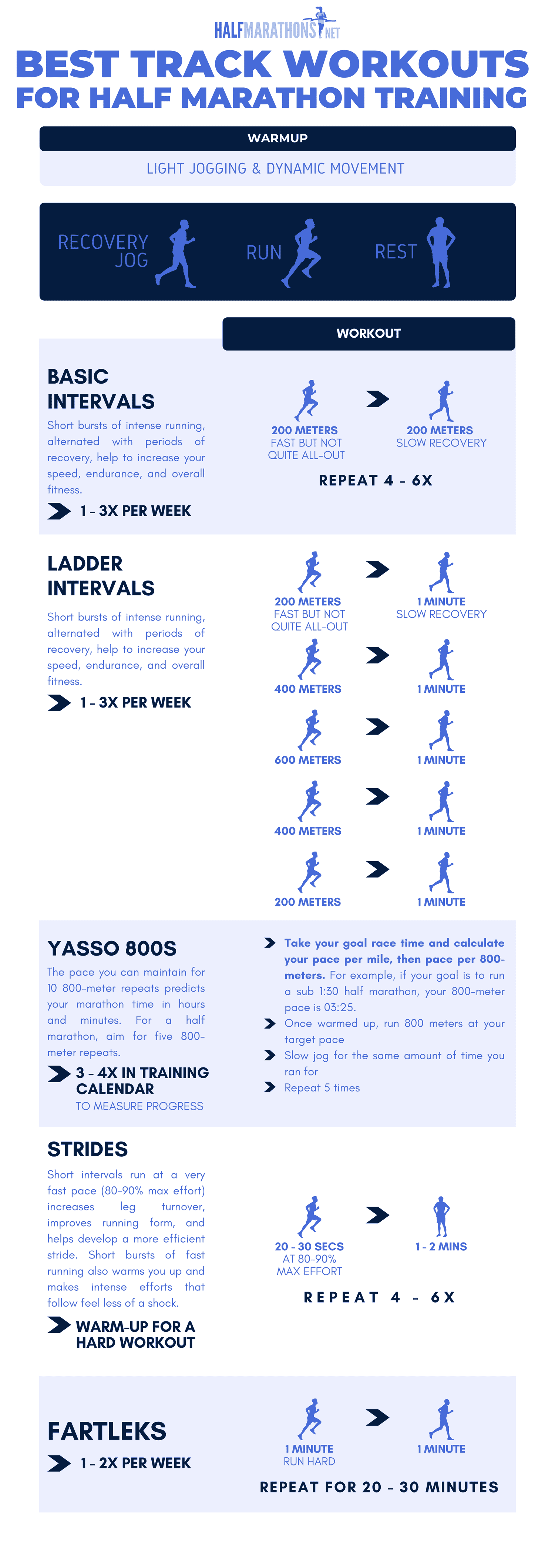
Are you tired of the same old running routine? Looking to take your training to the next level? Look no further than track workouts for distance runners!
Many distance runners shy away from track workouts, thinking they are only meant for shorter distance or elite runners. However, the speed work featured in track workouts offer benefits that translate to cardiovascular and endurance improvement in all types of runners — meaning you can run faster and longer whether you’re training for a 10k, half marathon, marathon, or even an ultramarathon.
As a high school track coach who’s participated in two U.S. Olympic Track & Field Trials, I know firsthand the value of hitting the track on a regular basis.
What Are Track Workouts, Exactly?
Simply put, track workouts are structured training sessions performed on a 400-meter running track. Track workouts traditionally involve shorter, faster intervals with structured rest periods.
The types of workouts vary, ranging from short sprints, to tempo runs, to longer interval work.

Why Distance Runners Should Do Track Workouts
Is your body tired of pounding the pavement day in and day out? Hoping for more noticeable improvement in your speed or endurance? Or wanting to spice up your training routine and add some variety to your workouts?
Whatever the case may be, maybe it’s time to consider incorporating track workouts into your training regimen.
Here are some benefits of these sorts of workouts for runners of all kinds.
- Improved Running Economy
First and foremost, track workouts can improve running economy — that is, the amount of oxygen your body consumes to maintain a given speed. Put simply, when you improve your running economy, you can run faster without increasing your effort. What runner doesn’t want that?
As distance runners, our longer, slower runs primarily tax the aerobic system. Intervals you run on a track are more anaerobically taxing, bumping up your heart rate and improving your body’s ability to run fast for longer periods of time.
You’d be hard-pressed to find a professional runner of any specialty (sprints up to ultras) who doesn’t put in the type of work typically seen in track workouts. But such work offers the same benefits for runners of all fitness and speed levels who are striving to get faster or achieve a specific goal.
How high should your heart rate get in these workouts? The answer varies depending on the type of workout you’re doing, but most of the time, track workouts for distance runners will entail Zone 4 or 5 efforts (your threshold paces and bumping up to your max heart rate).

- Lower Injury Risk
Improving your running economy can also help prevent running injuries. That’s because it helps lower the amount of stress on your muscles and joints. Track surfaces are significantly softer than concrete or asphalt. While track composition varies, running on a track is almost always easier on your joints and ligaments than running on the road.
Especially while living in urban places such as Houston and Dallas, I’ve made it a point to incorporate regular track work in my schedule, largely because of the break it gives my body — even when I’m running faster than I do on harder surfaces.
- Better Running Form
Running on a track promotes good running posture and form. This, in turn, reduces wear and tear on your body, reduces the risk of injury, and allows you to run as fast or faster with less effort.
Since tracks are flat and uniform, they present nice opportunities to focus on your stride, cadence, and foot strike. You don’t have to look for a straightaway section of road and worry about tripping over rocks, roots, or sidewalk cracks — you can just focus on your form.
I’ve also noticed, both with myself and the high school runners I coach, it’s easier to maintain proper form while running quicker, as you’re likely to do in a track workout. Compared to just plodding along on an easy run, in such workouts, you’re driving your knees, pumping your arms, and engaging more muscles — all of which make you a more efficient mover.

- Greater Running Variety
Another good reason to mix in some track workouts is to add variety to your training routine. Long, slow runs can get monotonous and lead to burnout if you aren’t careful.
It’s easy to get creative on a track. Depending on what you’re feeling on the day, you can run a bunch of 200-meter intervals or you can grind out a handful of mile reps. To keep it fresh, I tend to not repeat the same workout for a few weeks. When I do, I’m usually in better shape, and excited to see how much I’ve improved from the last time I ran the same track workout.
You can also incorporate different pacing strategies on the track such as negative splits (meaning running the second half of a rep or workout faster than the first) and fast finishes (which may look like running your last rep almost all-out), both of which add new challenges to your daily run.
By mixing it up, you’ll keep your body — and your mind — engaged and motivated.
- Comfort at Race Pace
Running track workouts can help you become more comfortable at your goal race pace. Many distance runners struggle with finding and maintaining the right pace during a race, especially if it’s a new distance or a challenging course.
By practicing interval workouts at your designated goal pace, you can train yourself to become more attuned to that speed and feel confident landing there on race day. And by running faster than goal pace, you can make that pace feel easier once you’re in the race, having touched speeds much faster in workouts.

The Best Track Workouts Distance Runners Can Do
Track workouts can be fun and challenging — and offer a surefire way to get faster, fast. If you’re at a point in your running where you’re determining how to run a faster half marathon in the shortest amount of time, these are the best track workouts for distance runners.
Remember to start with a warm-up and end with a cool-down jog, do some dynamic stretching before running hard, and give yourself sufficient rest between hard workout days. Most runners (myself included) can only handle 2-3 hard workouts per week, so take those hard days seriously, but don’t slack on your recovery between them.
Intervals
Intervals are short, intense bursts of running alternated with periods of rest or low-intensity recovery (such as 400m or 1 lap hard, followed by a 1-minute stand or walk, repeated a set number of times). The idea is to increase your speed, endurance, and overall fitness.
Intervals are typically performed on a standard running track, which is 400 meters per lap. Depending on your fitness level and goals, you can vary the distance, intensity, recovery, and number of intervals performed.
Interval Workout for Half Marathoners:
Before you start, make sure you warm up properly with some light jogging and dynamic movements.
- Start with 4-6 intervals of 200 meters at a fast, but not quite all-out, pace.
- Follow each interval with a recovery period of 200 meters run at a very slow pace.
As you progress, you can increase the speed of each 200m and/or the number of intervals performed. It may take you an attempt or two to identify a pace that’s challenging but sustainable for the whole workout.
Another type of interval workout is a ladder workout, where you gradually increase and then decrease the distance of each interval as you go. An example of a ladder workout is to start with 200 meters hard, then 400 meters, then 600 meters, then back down to 400 meters, and finally 200 meters again. Jog 1 minute very easy in between each rep.
Fartleks
First things first: what the heck is a fartlek? The name comes from the Swedish word for “speed play,” and that’s exactly what it is.
Fartleks involve alternating between periods of faster and slower running, sometimes in a structured way and sometimes without a set plan. A classic road fartlek might look like sprinting to a mailbox, jogging to the next mailbox, sprinting to the next mailbox, and so on. On a track, a fartlek might be 1 minute of hard running, 1 minute of easy running, 2 minutes hard, 2 minutes easy, and so on until you hit 8 minutes.
Because they offer less feedback than most other track workouts, I love running fartleks when I’m returning to running after an injury or a layoff, or when I don’t feel mentally sharp due to a poor night of sleep or some outside distraction. Once I get into the workout, I’m typically able to push harder than I realized, but without the stress of splits hanging over me.
Fartlek Workout for Half Marathoners:
Here’s a good fartlek workout to try on a track:
- Run hard for 1 minute.
- Jog or walk for 1 minute.
- Repeat for 20-30 minutes.
As you get fitter, you can try to extend those efforts to 90 seconds or 2 minutes, or increase the total time of the 1-minute on, 1-minute off workout.
Strides
Strides are short intervals run at a very fast pace. They should be done at about 80-90% of your maximum effort, with a focus on good form and quick cadence.
The purpose of strides is to increase your leg turnover, improve your running form, and help you develop a more efficient stride. They can also help you warm up for a hard workout.
Strides Workout for Half Marathoners:
The best way to incorporate strides into your training routine is to do them right before a hard workout. Short bursts of fast running warms you up and makes the efforts that follow feel like less of a shock than they otherwise would.
- Start with 4-6 strides, each lasting about 20-30 seconds.
- Rest 1-2 minutes in between.
- As you become more comfortable with strides, try to increase the speed at which you run them.
I’ve done strides at least once, and sometimes as often as 3 times, per week, year round, ever since I started running collegiately in 2007. I just love the way I feel afterwards, and the effect even lasts the next day—which is why I, and most of the people I’ve competed against, incorporate strides into runs the day before a race.
Good form is essential when doing strides.
Here are some tips to keep in mind:
- Focus on a quick turnover, with short, fast steps
- Keep your upper body relaxed and your shoulders down
- Keep your arms at a roughly 90-degree angle, with your elbows close to your body
- Practice driving your knees up high
- Think about putting as much force into the ground with each step as possible
Yasso 800s
Invented by Bart Yasso, the Chief Running Officer of Runner’s World, Yasso 800s is a popular workout that’s used to increase fitness as well as to predict someone’s marathon time. .
The basic premise of this workout is that whatever pace you can maintain for 10 800-meter repeats, there’s a good chance you can hold that pace for a full marathon in hours and minutes.
Yasso 800s Workout for Half Marathoners:
For example, if you aim to run a 3-hour marathon, your goal time for each of 10 800-meter repeats should be three minutes flat.
- Once you’re warmed up, run 10 800-meter repeats with a recovery jog in between each one.
- The recovery jog should be equal in time to the 800-meter interval, e.g., if you run the 800 in three minutes, then your recovery jog should be three minutes as well.
- The goal is to run as hard but also as consistently as possible while recovering enough in the alloted time to run the next interval at your predetermined pace.
If 10 800-meter repeats feel too daunting, you can start with five or six, and gradually work your way up to 10.
–





